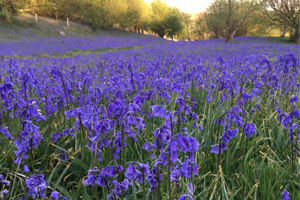Guests at Settle's Falcon Manor Hotel this spring should check out some of the finest bluebell displays in the area.
According to Jane Gara, general manager of Falcon Manor, the breathtaking carpets of blue at nearby Oxenber and Cleatop woods are a "Must See" in May.
Said Jane: "Cleatop Wood, near Settle, offers a lovely circular walk of around four miles from the door of Falcon Manor. A stroll along a green lane and across farmland brings guests to the woodland, a designated Site of Special Scientific Interest."
It is 10 minutes in the car to the village of Austwick from where Oxenber Wood can form part of a three to four mile circuit.
Jane said: "Stroll along bridleways and make your way uphill through this pasture of bluebells into the woods where the flowers continue in abundance.
"This is also an excellent wood for seeing primrose and orchids, which are typically out just before the bluebells."
Bluebells are usually in flower between late April and late May and two different species are commonly found in the Yorkshire Dales - the native bluebell identifiable by its white-cream coloured pollen, and the Spanish bluebell.
Some bluebell facts:
- The Latin name for bluebells is Hyacinthoides non-scripta.
- Bees love bluebells and sometimes bite a hole in the bottom of the bell to get to the nectar.
- Bluebell bulbs were crushed to provide starch for the ruffs of Elizabethan collars and sleeves. Meanwhile, back in the Bronze Age, bluebells were used to set feathers on arrows: a process known as ‘fletching'.
- Bluebells are long associated with fairy folklore - they are said to have been used to lure children into woods.
- Half the world's population of bluebells grow in the UK.
- It's illegal to pick, uproot or intentionally destroy bluebells.
Jane added: "Falcon Manor's dinner, bed and breakfast offers are particularly good value for enjoying a break and experiencing the bluebell display while relaxing in stunning surroundings. Keep an eye on www.falconmanor.co.uk for our April/May offers."



